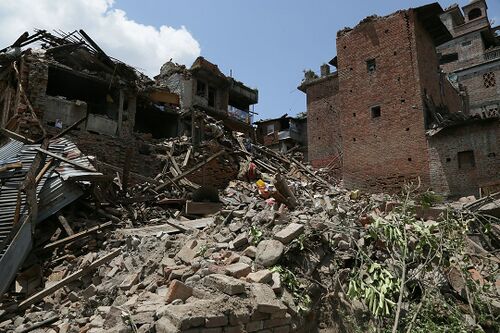What are Disasters and Conflicts: Difference between revisions
No edit summary |
No edit summary |
||
| Line 32: | Line 32: | ||
A tsunami, meaning 'harbour wave' in Japanese, is most often the result of an underwater earthquake, which creates a very large coastal wave. Generally the worlds largest tsunamis occur at convergent plate boundaries where two tectonic plates crash into each other with the collison forcing one tectonic plate down underneath the other. As this happens the leading edge of the top plate catches on the bottom plate and pressure starts to build, which is eventually released in the form of the most powerful type of earthquake, called a megathrust earthquake. When these megathrust earthquakes occur under water large amount of water is displaced and a tsunami wave occurs. | A tsunami, meaning 'harbour wave' in Japanese, is most often the result of an underwater earthquake, which creates a very large coastal wave. Generally the worlds largest tsunamis occur at convergent plate boundaries where two tectonic plates crash into each other with the collison forcing one tectonic plate down underneath the other. As this happens the leading edge of the top plate catches on the bottom plate and pressure starts to build, which is eventually released in the form of the most powerful type of earthquake, called a megathrust earthquake. When these megathrust earthquakes occur under water large amount of water is displaced and a tsunami wave occurs. | ||
<br> | <br> | ||
{{#ev:youtube| | {{#ev:youtube|oWzdgBNfhQU|250}} <div class="row"><div class="col-md-6 col-md-offset-3"><div class="text-right"><ref>National Geographic. Rare Video: Japan Tsunami | National Geographic. Available from: https://youtu.be/oWzdgBNfhQU[last accessed 26/02/22]</ref></div></div></div> | ||
===== Landslides ===== | ===== Landslides ===== | ||
Revision as of 05:09, 27 February 2022
Original Editors - Add your name/s here if you are the original editor/s of this page. User Name
Top Contributors - Naomi O'Reilly, Aminat Abolade, Tarina van der Stockt, Kim Jackson, Vidya Acharya, Jess Bell, Olajumoke Ogunleye and Ewa Jaraczewska
Introduction[edit | edit source]
Disaster, as defined by the United Nations, is a serious disruption of the functioning of a community or society, which involve widespread human, material, economic or environmental impacts that exceed the ability of the affected community or society to cope using its own resources [1]. Disaster management is how we deal with the human, material, economic or environmental impacts of said disaster, it is the process of how we “prepare for, respond to and learn from the effects of major failures” [2]. Though often caused by nature, disasters can have human origins. According to the International Federation of Red Cross & Red Crescent Societies a disaster occurs when a hazard impacts on vulnerable people. The combination of hazards, vulnerability and inability to reduce the potential negative consequences of risk results in disaster [3].
(VULNERABILITY+ HAZARD ) / CAPACITY = DISASTER [3]
When we think of disasters, we often automatically think of the phenomenon that has caused them – for example the earthquake, cyclone, or flood. In reality, though, this event is simply the ‘hazard’ – and the disaster itself is caused by a combination of the hazard, our own exposure to the phenomenon (such as whether we live in the area affected) and our vulnerability to it (how we have prepared or mitigated for it). Natural disasters and armed conflict have marked human existence throughout history and have always caused peaks in mortality and morbidity.
This article examines the advances in the humanitarian response to public health over the past fifty years and the challenges currently faced in managing natural disasters and armed conflict [4].
Types of Disaster[edit | edit source]
Sudden Onset Disasters[edit | edit source]
According to the International Federation of Red Cross & Red Crescent Societies sudden onset disasters, often termed natural disasters are naturally occurring physical phenomena caused either by rapid or slow onset events that have immediate impacts on human health and secondary impacts causing further death and suffering. The United Nations Office for Disaster Risk Reduction characterises Natural Disasters in relation to their magnitude or intensity, speed of onset, duration and area of extent e.g. earthquakes are of short duration and usually affect a relatively small region whereas droughts are slow to develop and fade away and often affect large regions [1]. These disasters can be [5]:
Geophysical[edit | edit source]
A geophysical hazard is a potentially damaging natural event and/or phenomenon, which may cause the loss of life or injury, property damage, social and economic disruption, or environmental degradation.
Earthquakes[edit | edit source]
Earthquakes are sudden tremors or vibrations that occur in the Earth’s crust that occur as a result of tectonic plates colliding or trying to slide past each. This causes a build-up of pressure between the two plates in the Earth’s crust along what is called a fault line. When the plates move at the fault line sudden pressure is released and causes a violent shaking of the earth’s surface in the form of an earthquake. Earthquakes in particular cause a significant burden of injuries, mainly of the limb with fracture incidence shown to correlate with the Richter Magnitude Scale, where high-energy earthquakes cause more fractures.[6][7] MacKenzie et al [8] found that fractures accounted for 65% of the total injuries following earthquakes with lower extremities fractures accounting for 59% of those injuries. Bortolin et al [6] found that 10% of fractures involved the pelvic ring, while spinal column fractures accounted for 17% of the total injuries, with more than 4% of these involving spinal cord injury.[7]Tsunamis[edit | edit source]
A tsunami, meaning 'harbour wave' in Japanese, is most often the result of an underwater earthquake, which creates a very large coastal wave. Generally the worlds largest tsunamis occur at convergent plate boundaries where two tectonic plates crash into each other with the collison forcing one tectonic plate down underneath the other. As this happens the leading edge of the top plate catches on the bottom plate and pressure starts to build, which is eventually released in the form of the most powerful type of earthquake, called a megathrust earthquake. When these megathrust earthquakes occur under water large amount of water is displaced and a tsunami wave occurs.
Landslides[edit | edit source]
Volcanic Activity[edit | edit source]
Hydrological[edit | edit source]
Avalanches[edit | edit source]
Floods[edit | edit source]
Climatological[edit | edit source]
Extreme Temperatures[edit | edit source]
Wildfires[edit | edit source]
Drought[edit | edit source]
Meteorological[edit | edit source]
Meteorological hazards occur as a result of processes in the atmosphere and include cyclones hurricanes, tornadoes, and severe storms.
Cyclones[edit | edit source]
Known as hurricanes, cyclones and typhoons depending on where in the world they appear, these storms typically occur in seasons and with lead times of several days, although their paths can alter, with storm surges in coastal areas particularly dangerous. Although preparedness has the potential to significantly lower mortality and morbidity.
High-income countries account for most of the mortality and morbidity data from cyclones, although most deaths and injuries do result from sequelae such as flooding and landslides rather than directly from the wind. Main reported injuries include contusions and lacerations (particularly to the head and extremities) occurring mainly during strong cyclones where shelter has been limited with serious injuries such as fractures as low as 1% of all injuries, although a significant proportion of indirect injuries, such as electrocution and burns, occur during clean-up activities.
Scales for measuring tropical cyclones vary depending on where in the world they occur, but the Saffir-Simpson Hurricane Scale provides a useful illustration of the impact of windspeeds:
Storms/Wave Surges[edit | edit source]
Biological[edit | edit source]
Disease Epidemics[edit | edit source]
Insect/Animal Plagues)[edit | edit source]
Man-Made Disasters[edit | edit source]
Man-Made Disasters as viewed by the International Federation of Red Cross & Red Crescent Societies are events that are caused by human activities or choices, which occur in or close to human settlements often as a result of Environmental or Technological Emergencies. This can include [3]:
- Environmental Degradation
- Industrial Pollution
- Accidents (e.g. Industrial, Technological and Transport usually involving the production, use or transport of hazardous materials)
Complex Emergencies[edit | edit source]
Some disasters can result from multiple hazards, or, more often, to a complex combination of both natural and man-made causes which involve a break-down of authority, looting and attacks on strategic installations, including conflict situations and war. These can include [12]:
- Food Insecurity
- Epidemics
- Armed Conflicts
- Terrorist Attacks
- Displaced Populations
According to ICRC these Complex Emergencies are typically characterized by [12]:
- Extensive Violence
- Displacements of Populations
- Loss of Life
- Widespread Damage to both Societies and Economies
- Need for Large-scale, Humanitarian Assistance across Multiple Agencies
- Political and Military Constraints which impact or prevent Humanitarian Assistance
- Increased Security Risks for Humanitarian Relief Workers
Pandemic Emergencies[edit | edit source]
Pandemic (from Greek πᾶν pan "all" and δῆμος demos "people") is an epidemic of infectious disease that has spread across a large region, which can occur to the human population or animal population and may affect health and disrupt services leading to economic and social costs. It may be an unusual or unexpected increase in the number of cases of an infectious disease which already exists in a certain region or population or can also refer to the appearance of a significant number of cases of an infectious disease in a region or population that is usually free from that disease. Pandemic Emergencies may occur as a consequence of natural or man-made disasters. These have included the following epidemics:[13] [14]
Heading 3 [edit | edit source]
Add your content to this page here!
Resources[edit | edit source]
References [edit | edit source]
see adding references tutorial.
- ↑ 1.0 1.1 United Nations Office for Disaster Risk Reduction. Terminology. http://www.unisdr.org/we/inform/terminology#letter-p [Accessed 29 Nov 2016]
- ↑ Elliott D. Disaster and Crisis Management. In The Handbook of Security 2014 (pp. 813-836). Palgrave Macmillan UK.
- ↑ 3.0 3.1 3.2 International Federation of Red Cross and Red Crescent Societies. What is a Disaster. http://www.ifrc.org/en/what-we-do/disaster-management/about-disasters/what-is-a-disaster/. [Accessed: 9 Jan 2017]
- ↑ Leaning J, Guha-Sapir D. Natural Disasters, Armed Conflict, and Public Health. New England Journal of Medicine. 2013 Nov 7;369(19):1836-42
- ↑ International Federation of Red Cross and Red Crescent Societies. Types of Disasters. http://www.ifrc.org/en/what-we-do/disaster-management/about-disasters/definition-of-hazard/. [Accessed: 02 Jan 2017]
- ↑ 6.0 6.1 Bortolin M, Morelli I, Voskanyan A, Joyce NR, Ciottone GR. Earthquake-related orthopedic injuries in adult population: a systematic review. Prehospital and disaster medicine. 2017 Apr;32(2):201-8.
- ↑ 7.0 7.1 Bartholdson S, von Schreeb J. Natural disasters and injuries: what does a surgeon need to know?. Current trauma reports. 2018 Jun;4(2):103-8.
- ↑ MacKenzie JS, Banskota B, Sirisreetreerux N, Shafiq B, Hasenboehler EA. A review of the epidemiology and treatment of orthopaedic injuries after earthquakes in developing countries. World journal of emergency surgery. 2017 Dec;12(1):1-7.
- ↑ Physiopedia. A introduction to the new Physiopedia Plus. Available from: https://youtu.be/_r_nFT2m-Vg[last accessed 26/02/22]
- ↑ National Geographic. Rare Video: Japan Tsunami | National Geographic. Available from: https://youtu.be/oWzdgBNfhQU[last accessed 26/02/22]
- ↑ Bureau of Meteorology. Understanding Tropical Cyclone Categories. Available from: https://youtu.be/qTV8Qft6Nco[last accessed 26/02/22]
- ↑ 12.0 12.1 International Federation of Red Cross and Red Crescent Socities. Complex/Manmade Hazards: Complex Emergencies. http://www.ifrc.org/en/what-we-do/disaster-management/about-disasters/definition-of-hazard/complex-emergencies/. [Accessed 18 Dec 2016]
- ↑ WCPT. What is Disaster Management. http://www.wcpt.org/disaster-management/what-is-disaster-management. [Accessed 8 Jan 2017].
- ↑ Wikipedia. Pandemics. https://en.wikipedia.org/wiki/Pandemic. [Accessed: 3 Jan 2017]








